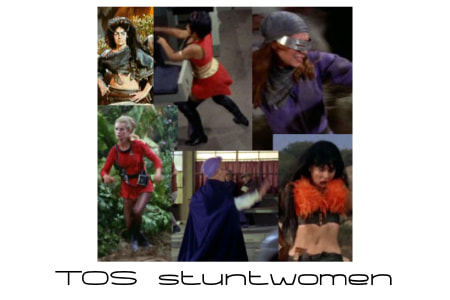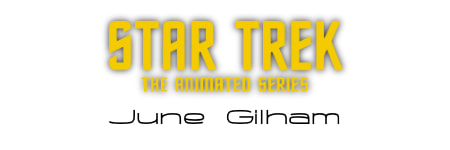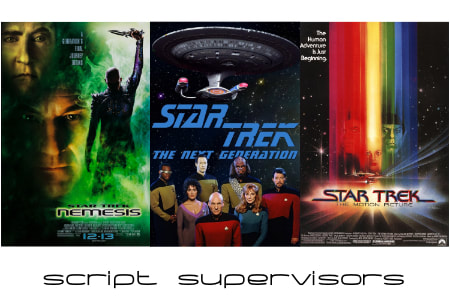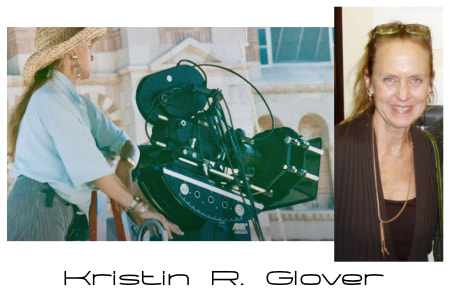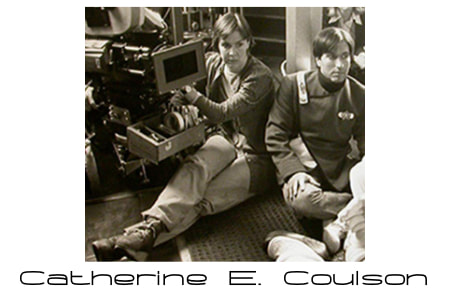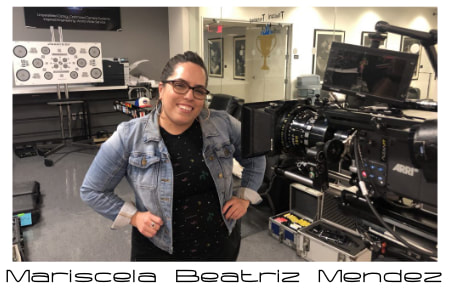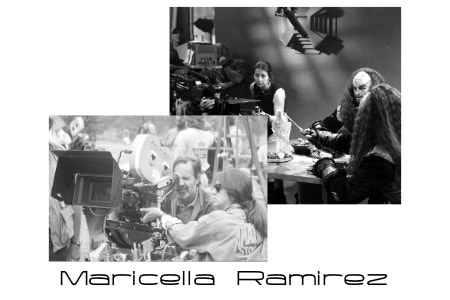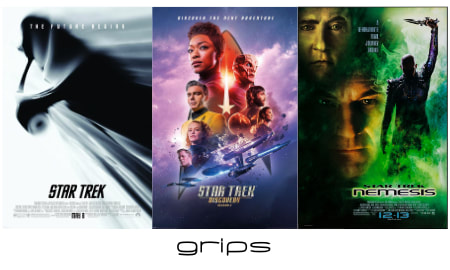 This series has already covered most of the jobs related to film and television production, including all of the glamorous careers like writing, producing, directing, music & sound, art & design, and costume & makeup. What could possibly be left to talk about? A lot, surprisingly! There's a huge team of people performing the lesser known yet crucial tasks that keep a show organized, as well as an army of technical specialists that maintain and employ the vast amounts of equipment needed to bring a show from inception to completion. Happily there are several women who have performed these roles for Star Trek, and you're about to meet some of them! P.S. Most of the info below was drawn from imdb.com, memory-alpha.fandom.com, and linked interviews. While I've done my best to be thorough, I admit my fallibility and welcome corrections. The vast majority of women credited with working on Trek have little to no information available about them, and photos are even more scarce. Also, shorts, video games, books, comics, and fan-made media are not included. Stuntwomen might not technically be "behind" the camera, but seeing as how NOT ONE of the female stunt actors on TOS were credited, they're hidden enough to merit some love, and our production list seems as good a place as any to give it. Seven women performed all sorts of stunts on TOS, ranging from disarming attackers to getting hit by a car. Most notable among them are Nedra Rosemond-Watt (pictured top center), the only stuntwoman of color, and Julie Ann Johnson (bottom left), who would go on to become one of Hollywood's highest paid stuntwomen and fight against its dangerous and unethical practices. The other five stuntwomen were (clockwise) Carol Daniels, Donna Garrett, Regina Parton, Mary Statler, and (not pictured) Irene Sale. *On a related note, NO women have ever been stunt coordinator for any Trek property. Leslie Hoffman got the closest, working as both assistant stunt coordinator and a stunt actor on the DS9 episode "Badda-Bing, Badda-Bang." Photos via IMDB and Memory Alpha We met Merri Howard back in the producers post, but as the first woman to be a production manager (a.k.a. unit production manager) for Trek, she merits inclusion here as well. The production manager is one of the most important administrative positions for a film or TV show. They are among the top decision makers, working with producers to develop schedules and budgets, as well as make sure those plans are actually followed. The production manager and her staff are also responsible for location scouting before filming starts, and acquiring any necessary permits related to using those locations; hiring production crews and contractors; safety and labor regulation compliance; and managing the logistics of housing and transportation for the cast and crew for the duration of the film. Howard was production manager for all of the third, fourth, and fifth seasons of TNG. Photo via StarTrek.com What does a film coordinator do? Google answers that question by telling me what a "production coordinator" does, so I'm guessing they're the same? Essentially, the production/ film coordinator is the production manager's right-hand woman, helping handle all of the messy logistics related to making a movie or TV show like budgets, schedules, catering, equipment rentals, etc. Gilham was the first woman to hold the position, serving in this role for all 22 TAS episodes. She's also the first woman to work outside of the costume & wardrobe, writing, and art departments for Trek. Gilham clearly excelled at what she did, working as film coordinator for almost sixty different shows and movies, including She-Ra: Princess of Power and He-Man and the Masters of the Universe. She also worked as a negative cutter for almost thirty years. Filming for a show never happens in the same order as the show itself, nor does it happen all in one seamless, perfect take. When the filming of a scene gets interrupted, whether by lunch or a flubbed line, someone has to keep track of every detail -- from exactly where the actors were standing to how the scene was lit -- to ensure consistency for the viewer. The role of script supervisor was invented back in the late 1910s when audience expectations were beginning to rise and films became more complex. The "script clerk," as it was then known, quickly became one of the few production jobs that was performed almost exclusively by women, probably because the role was viewed as similar to a secretary. Among the numerous women who have served as script supervisor for Trek, the most notable are Bonnie Prendergast, Trek's first female script supervisor; Kerry Lyn McKissick, the first woman of color script supervisor; and Joyce Heftel, who worked on all 176 episodes of TNG, the most of any woman. Star Trek: The Motion Picture is Prendergast's only Trek credit, but during her four decades in the industry, she worked on almost 40 shows and movies, including such classics as The Simpsons, Cheers, and Rocky. McKissick's first credit was back in 1980, and after almost 100 shows she's still going strong today, working on the upcoming Godzilla vs. Kong, a ton of Marvel movies, and -- her only Trek credit -- Nemesis. Heftel is another industry stalwart, with her earliest credit on a 1976 show called The Gong Show, and her most recent on the upcoming movie Mindcraft. Images via IMDB Moving on to the camera & lighting department, the head honcho in this area is the director of photography, also sometimes known as the cinematographer. Unfortunately, ZERO women have held this position in all of Star Trek. Kristin R. Glover is one of two women who have come the closest, working as a camera operator (the other is Jessica Lakoff Cannon on Picard). Camera operators do exactly what you expect: they operate the camera. While this may seem like a fairly straightforward job of "point and shoot," the cameras used are extremely complex and require a high level of technical expertise. Glover was Trek's first female camera operator, filling the role for both The Undiscovered Country and one episode of DS9 ("Defiant"). At the time of her first job (as first assistant camera on the Arnold Schwarzeneggar documentary Pumping Iron), she was one of only a few women working in this role. Facing constant harassment, accusations of nepotism, and even outright sabotage, she rose to become a cinematographer and director in her own right, even serving on the board of the Local 600 International Cinematographers Guild. Other credits include American Gigolo, Hoffa, Hocus Pocus, and a documentary about the Dalai Lama. Images via Kristin R. Glover / Pioneer Hollywood Camera Women / Documentary As first assistant camera on Wrath of Khan, Catherine E. Coulson was the first woman to work in the camera & electrical department for Star Trek. In this role, which is also known as a focus puller, she was responsible for adjusting the focusing ring on the camera lens. This job is regarded as one of the most challenging on set, making sure that the object or actor of the scene remains in focus, regardless of motion either in front of or behind the camera. If you're a fan of the show Twin Peaks, you'll know Coulson better as the Log Lady. Other credits include the 1977 cult horror film Eraserhead, the 1991 film Night on Earth, and the TV series Portlandia. Photo via IMDB While several women are credited with working in the camera & electrical department on various Trek properties, unfortunately I couldn't find photos or biographies for the vast majority of them. Based on those I could find, Mariscela Beatriz Mendez was the first and only woman of color to work in this department for Trek. Now a highly in-demand cinematographer, Mendez served as a lighting technician for Into Darkness. Not only has she worked on such acclaimed shows as Amazon's Adulting, she's also a member of The American Society of Cinematographer's Vision Mentorship Program. Photo via voyagela.com Since 1987, similarly named Maricella Ramirez has been behind the camera for more than fifty movies and shows. She came to Star Trek as a trainee on the TNG pilot and ended up working on almost sixty episodes, eventually getting promoted to first assistant camera. She also served in this capacity on several DS9 and Voyager episodes, making her the record holder for woman with the most Trek credits in the camera & lighting department, with a total of 118 episodes under her belt. Her other work includes the recent Netflix series Space Force, the 2016 film Jack Reacher: Never Go Back, Freaky Friday (2003), and The Fast and the Furious. Photos via moon-city-garbage.agency and icgmagazine.com Among the many benefits of writing this blog series is learning what the heck all of the weird job titles on the end credits mean, including the innocuously named grip. Such a little word, but it's actually a hugely important role, as this person is responsible for assembling and maintaining all of the equipment related to the cameras -- this could include cranes, tracks, dollies, tripods, and whatever else the camera might sit on. With 21 shows and movies spread over the past 50+ years, only three women have worked in this capacity for Trek: Amber Maahs (Nemesis), Arlene Brown (2009's Star Trek), and M. Victoria Low (3 episodes of Discovery). Unfortunately I couldn't find pictures or much info for any of them, but the fact that they were able to break into such a male-dominated field is a testament to their skill and persistence. Photos via IMDB Female electricians are rare no matter where you go, and this holds true in Hollywood as well. Only three women (including the aforementioned Mariscela Beatriz Mendez) have been on the Star Trek lighting or electrical crews. Jenna Abrahamson-Minardi was the first, working as a lighting technician on both The Undiscovered Country and Generations. Tracy Estes was on the electrical rigging crew (the prep team that rigs the set with all of the cables and lights before filming starts) for Nemesis, and is the only woman in all of Trek to do so. Rachel Wells worked as a straight up electrician for the final two episodes of Enterprise, and she's also the only woman ever listed as filling this position for Trek. The last of the five is Natasha Denis, who was the only female rigging grip (setting up lights on set) in all of Trek (Beyond), as well as a stuntwoman and actress on shows and movies including Elysium, The 100, and The Predator. Photos via IMDB Thanks so much for stopping by! Want to learn about more women behind the scenes? Hop on over next week for the next installment of Unseen Women of Star Trek: Post-Production.
Comments are closed.
|
Archives
June 2021
Categories
All
|
- Home
- What is an Awesome Woman?
-
- Oyinkan Abayomi
- Jane Addams
- Fatima al-Fihri
- Jessie Daniel Ames
- Susan B. Anthony
- Inessa Armand
- Ella Baker
- Josephine Butler
- Mary Shadd Cary
- Septima Clark
- Dorothy Day
- Durgabai Deshmukh
- Nawal El Saadawi
- Lady Bird Johnson
- Helen Keller
- Coretta Scott King
- Anne Carroll Moore
- Rosa Parks
- Alice Paul
- Eleanor Roosevelt
- Ghenia Avril de Sainte-Croix
- Sophie Scholl
- Doria Shafik
- Elizabeth Cady Stanton
- Sojourner Truth
- Harriet Tubman
- Malala Yousafzai
-
-
- Nicola Adams
- Laila Ali
- Simone Biles
- Bonnie Blair
- Alice Coachman
- Nadia Comaneci
- Dominique Dawes
- Keiko Fukuda
- Tanni Grey-Thompson
- Sonja Henie
- Florence Griffith Joyner
- Jackie Joyner-Kersee
- Ibtihaj Muhammad
- Annie Smith Peck
- Wilma Rudolph
- Junko Tabei
- Lindsey Vonn
- Kristi Yamaguchi
- "Babe" Didrikson Zaharias
-
- Ama Ata Aidoo
- Anna Akhmatova
- Louisa May Alcott
- Isabel Allende
- Maya Angelou
- Jane Austen
- Mary Ritter Beard
- Hildegard von Bingen
- Nellie Bly
- Gwendolyn Brooks
- Octavia Butler
- Sor Juana Ines de la Cruz
- Tsitsi Dangarembga
- Emily Dickinson
- Marjory Stoneman Douglas
- Lorraine Hansberry
- Toni Morrison
- Sappho
- Harriet Beecher Stowe
- Ida B. Wells
-
- Mary Kay Ash
- Olive Ann Beech
- Polly Bemis
- Marguerite Boucicaut
- Juana Briones
- Clara Brown
- Nellie Cashman
- Coco Chanel
- Nicole-Barbe Clicquot
- Ellen Demorest
- Katharine Graham
- Hetty Green
- Isabella Greenway
- Annie Turnbo Malone
- Indra Nooyi
- Charley Parkhurst
- Eliza Pinckney
- Lydia Pinkham
- Mary Ellen Pleasant
- Muriel Siebert
- Madam C.J. Walker
- Maggie Lena Walker
- Marie Webster
- Oprah Winfrey
-
- Corazon Aquino
- Queen Yaa Asantewaa
- Mavis Batey
- Mary McLeod Bethune
- Empress Taytu Betul
- Queen Boudicca
- Mary Bowser
- Charlotte Hawkins Brown
- Gro Harlem Brundtland
- Nannie Helen Burroughs
- Empress Catherine II of Russia
- Violeta Barrios de Chamorro
- Shirley Chisholm
- Pharaoh Cleopatra VII
- Sarah Emma Edmonds
- Queen Elizabeth I of England
- Ruth Bader Ginsburg
- Pharaoh Hatshepsut
- Noor Inayat Khan
- Belva Lockwood
- Patsy Mink
- Sandra Day O'Connor
- Deborah Sampson
- Trung Sisters
-
-
- Rachel Carson
- Eugenie Clark
- Sylvia Earle
- Dian Fossey
- Rosalind Franklin
- Jane Goodall
- Ruth Handler
- Mary Jackson
- Shirley Ann Jackson
- Stephanie Kwolek
- Hedy Lamarr
- Mary Leakey
- Wangari Maathai
- Mary Sherman Morgan
- Ellen Ochoa
- Sally Ride
- Stephanie Schwabe
- Donna Shirley
- Kathryn Sullivan
- Ruth Wakefield
- Peggy Whitson
- Wu Chien-Shiung
-
-
- Virginia Apgar
- Sara Josephine Baker
- Alice Ball
- Clara Barton
- Patricia Bath
- Elizabeth Blackwell
- Louyse Bourgeoise Boursier
- Rachel Fuller Brown
- Mamie Phipps Clark
- Gertrude Belle Elion
- Marie Equi
- Elizabeth Hazen
- Dorothy Crowfoot Hodgkin
- Karen Horney
- Mae Jemison
- Anandibai Joshee
- Mary Eliza Mahoney
- Florence Nightingale
- Ogino Ginko
- Mary Seacole
- Jane Cooke Wright
- Rosalyn Yalow
-
- Alicia Alonso
- Marian Anderson
- Josephine Baker
- Lucille Ball
- Misty Copeland
- Dorothy Dandridge
- Ellen DeGeneres
- Katherine Dunham
- Ella Fitzgerald
- Evelyn Glennie
- Martha Graham
- Audrey Hepburn
- Katharine Hepburn
- Billie Holiday
- Nichelle Nichols
- Annie Oakley
- Dolly Parton
- Mary Pickford
- Ma Rainey
- Rihanna
- Yma Sumac
- Maria Tallchief
- Rosetta Tharpe
- Raven Wilkinson
- Picture Book Biographies
- Bulletin of Awesomosity (aka, the blog)
- About the Library
- Awesome Women Resources
- Contact
- Home
- What is an Awesome Woman?
-
- Oyinkan Abayomi
- Jane Addams
- Fatima al-Fihri
- Jessie Daniel Ames
- Susan B. Anthony
- Inessa Armand
- Ella Baker
- Josephine Butler
- Mary Shadd Cary
- Septima Clark
- Dorothy Day
- Durgabai Deshmukh
- Nawal El Saadawi
- Lady Bird Johnson
- Helen Keller
- Coretta Scott King
- Anne Carroll Moore
- Rosa Parks
- Alice Paul
- Eleanor Roosevelt
- Ghenia Avril de Sainte-Croix
- Sophie Scholl
- Doria Shafik
- Elizabeth Cady Stanton
- Sojourner Truth
- Harriet Tubman
- Malala Yousafzai
-
-
- Nicola Adams
- Laila Ali
- Simone Biles
- Bonnie Blair
- Alice Coachman
- Nadia Comaneci
- Dominique Dawes
- Keiko Fukuda
- Tanni Grey-Thompson
- Sonja Henie
- Florence Griffith Joyner
- Jackie Joyner-Kersee
- Ibtihaj Muhammad
- Annie Smith Peck
- Wilma Rudolph
- Junko Tabei
- Lindsey Vonn
- Kristi Yamaguchi
- "Babe" Didrikson Zaharias
-
- Ama Ata Aidoo
- Anna Akhmatova
- Louisa May Alcott
- Isabel Allende
- Maya Angelou
- Jane Austen
- Mary Ritter Beard
- Hildegard von Bingen
- Nellie Bly
- Gwendolyn Brooks
- Octavia Butler
- Sor Juana Ines de la Cruz
- Tsitsi Dangarembga
- Emily Dickinson
- Marjory Stoneman Douglas
- Lorraine Hansberry
- Toni Morrison
- Sappho
- Harriet Beecher Stowe
- Ida B. Wells
-
- Mary Kay Ash
- Olive Ann Beech
- Polly Bemis
- Marguerite Boucicaut
- Juana Briones
- Clara Brown
- Nellie Cashman
- Coco Chanel
- Nicole-Barbe Clicquot
- Ellen Demorest
- Katharine Graham
- Hetty Green
- Isabella Greenway
- Annie Turnbo Malone
- Indra Nooyi
- Charley Parkhurst
- Eliza Pinckney
- Lydia Pinkham
- Mary Ellen Pleasant
- Muriel Siebert
- Madam C.J. Walker
- Maggie Lena Walker
- Marie Webster
- Oprah Winfrey
-
- Corazon Aquino
- Queen Yaa Asantewaa
- Mavis Batey
- Mary McLeod Bethune
- Empress Taytu Betul
- Queen Boudicca
- Mary Bowser
- Charlotte Hawkins Brown
- Gro Harlem Brundtland
- Nannie Helen Burroughs
- Empress Catherine II of Russia
- Violeta Barrios de Chamorro
- Shirley Chisholm
- Pharaoh Cleopatra VII
- Sarah Emma Edmonds
- Queen Elizabeth I of England
- Ruth Bader Ginsburg
- Pharaoh Hatshepsut
- Noor Inayat Khan
- Belva Lockwood
- Patsy Mink
- Sandra Day O'Connor
- Deborah Sampson
- Trung Sisters
-
-
- Rachel Carson
- Eugenie Clark
- Sylvia Earle
- Dian Fossey
- Rosalind Franklin
- Jane Goodall
- Ruth Handler
- Mary Jackson
- Shirley Ann Jackson
- Stephanie Kwolek
- Hedy Lamarr
- Mary Leakey
- Wangari Maathai
- Mary Sherman Morgan
- Ellen Ochoa
- Sally Ride
- Stephanie Schwabe
- Donna Shirley
- Kathryn Sullivan
- Ruth Wakefield
- Peggy Whitson
- Wu Chien-Shiung
-
-
- Virginia Apgar
- Sara Josephine Baker
- Alice Ball
- Clara Barton
- Patricia Bath
- Elizabeth Blackwell
- Louyse Bourgeoise Boursier
- Rachel Fuller Brown
- Mamie Phipps Clark
- Gertrude Belle Elion
- Marie Equi
- Elizabeth Hazen
- Dorothy Crowfoot Hodgkin
- Karen Horney
- Mae Jemison
- Anandibai Joshee
- Mary Eliza Mahoney
- Florence Nightingale
- Ogino Ginko
- Mary Seacole
- Jane Cooke Wright
- Rosalyn Yalow
-
- Alicia Alonso
- Marian Anderson
- Josephine Baker
- Lucille Ball
- Misty Copeland
- Dorothy Dandridge
- Ellen DeGeneres
- Katherine Dunham
- Ella Fitzgerald
- Evelyn Glennie
- Martha Graham
- Audrey Hepburn
- Katharine Hepburn
- Billie Holiday
- Nichelle Nichols
- Annie Oakley
- Dolly Parton
- Mary Pickford
- Ma Rainey
- Rihanna
- Yma Sumac
- Maria Tallchief
- Rosetta Tharpe
- Raven Wilkinson
- Picture Book Biographies
- Bulletin of Awesomosity (aka, the blog)
- About the Library
- Awesome Women Resources
- Contact


